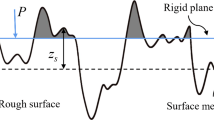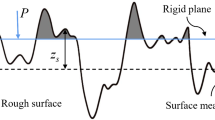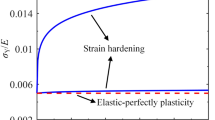Abstract
Human skin possesses complex deformation behaviour in multi-asperity contact. The deformation interaction under multi-asperity contact is prodigious in the skin contact model, must not be neglected. The phenomenon of non-uniform deformation has to be taken into account in order to properly and accurately develop a contact behaviour model of human skin. In this paper, one tribological model of contact behavior of human skin is developed with the concern of non-uniformation deformation behaviour under multi-asperity contact. Hertz, and DMT based theories were optimized for expatiating upon the tribological interaction between the human skin and the product surface. The model has been utilized to analyze the skin in multi-asperity contact. Results from FEM deformation simulation validated that deformation interaction between asperities is one of the important controlling factors which influences the deformation behaviour of skin in multi-asperity contact. Whilst asperities spacing was decreased, deformation interference was strongly noticed, and multi-asperity contact points were interfering adjacent deformation regime in irregular manner causing non-uniform deformation of skin. Furthermore, the total contact area tended to decrease when lambda spacing decreased.






Similar content being viewed by others
Abbreviations
- a :
-
Radius of the contact area (m)
- A :
-
Area of contact (m2)
- E :
-
YOUNG’S modulus (Pa)
- E* :
-
Reduced Young’s modulus (Pa)
- \( F_{adh} \) :
-
Adhesion force (N)
- \( F_{N} \) :
-
Applied normal load (N)
- \( h_{i} \) :
-
Height of an individual asperity (m)
- δ:
-
Indentation depth, deformation (m)
- N :
-
Total number of the asperities in contact
- R :
-
Radius of asperity (m)
- λ :
-
Spacing between asperities (m)
- δ :
-
Deformation due to the contact (m)
- \( \nu \) :
-
Poisson’s ratio
- \( \tau_{0} \) :
-
Shear strength of the interface (Pa)
- \( \beta \) :
-
Viscoelastic loss fraction
- \( \beta_{ve} \) :
-
Viscoelastic hysteresis
- \( \Delta \gamma \) :
-
Surface energy (N/m)
References
Attard P (2000) Interaction and deformation of elastic bodies: origin of adhesion hysteresis. J Phys Chem B 104:10635–10641
Dellon ES, Keller K, Moratz V, Dellon AL (1995) The relationships between skin hardness, pressure perception and two-point discrimination in the fingertip. J Hand Surg 20B:44–48
Derjaguin BV, Muller VM, Toporov YP (1975) Effect of contact deformations of the adhesion of particles. J Colloid Interface Sci 53:314–326
Derler S, Schrade U, Gerhardt LC (2007) Tribology of human skin and mechanical skin equivalents in contact with textiles. Wear 263:1112–1116
Flanagan JR, Lederman SJ (2001) Feeling bumps and holes. Nature 412:389–390
Gerhardt LC, Schmidt J, Sanz-Herrera JA, Baaijens FPT, Ansari T, Peters GWM, Oomens CWJ (2012) A novel method for visualising and quantifying through-plane skin layer deformations. J Mech Behav Biomed Mater 14:199–207
Hendriks FM, Brokken D, Oomens CWJ, Bader DL, Baaijens FPT (2006) The relative contributions of different skin layers to the mechanical behaviour of human skin in vivo using suction experiments. Med Eng Phys 28:259–266
Hertz H (1881) Ueber die Berührung fester elastischer Körper. J Reine Angew Math 92:156–171
Johnson KL, Kendall K, Roberts AD (1971) Surface energy and the contact of elastic solids. Proc R Lond A 324:301–313
Li W, Pang Q, Jiang Y (2012) Study of physiological parameters and comfort sensations during friction contacts of human skin. Tribol Lett 48:293–304
Odland G (1991) Structure of skin. In: Goldsmith LA (ed) Physiology, biochemistry, and molecular biology of the skin. Oxford University Press, Oxford
Pailler-Mattei C, Zahouani H (2006) Analysis of adhesive behaviour of human skin in vivo by an indentation test. Tribol Int 39:12–21
Pailler-Mattei C, Bec S, Zahouani H (2008) In vivo measurements of the elastic mechanical properties of human skin by indentation test. Med Eng Phys 30:599–606
Pereira JM, Mansour JM, Davis BR (1991) Dynamic measurement of the viscoelastic properties of skin. J Biomech 24:157–162
Pierard-Franchimont C, Damseaux M, Melotte P, Pierard GE (1988) The fate of hypodermis after liposuction surgery. J Am Acad Dermatol 19:723–728
Prokopovich P, Perni S (2011) Comparison of JKR- and DMT-based multi-asperity adhesion model: theory and experiment. Colloids Surf A Physiochem Eng Aspects 383:95–101
Shao F, Childs THC, Barnes CJ, Henson B (2010) Finite element simulations of static and sliding contact between a human fingertip and textured surfaces. Tribol Int 43:2308–2316
Silver FH, Siperko LM, Seehra GP (2003) Mechanobiology of force transduction in dermal tissue. Skin Res Technol 9:3–23
Skvarla J (2001) Hydrophobic interaction between macroscopic and microscopic surfaces. Unification using surface thermodynamics. Adv Colloid Interface Sci 91:335–390
van Kuilenburg J, Masen MA, Groenendijk MNW, Bana V, van der Heide E (2012) An experimental study on the relation between surface texture and tactile friction. Tribol Int 48:15–21
Wu KS, van Osdol WW, Dauskardt RH (2006) Mechanical properties of human stratum corneum: effects of temperature, hydration, and chemical treatment. Biomaterials 27:785–795
Yuan Y, Verma R (2006) Measuring microelastic properties of stratum corneum. Colloids Surf B 48:6–12
Acknowledgements
This work was supported by the Program for the Strategic Research Foundation at Private Universities (S1411010) from Japanese Ministry of Education, Culture, Sports, Science and Technology (MEXT). Special thanks to Prof. Emile van der Heide from University of Twente for patient and scholarly discussions.
Author information
Authors and Affiliations
Corresponding author
Rights and permissions
About this article
Cite this article
Zhang, S. Modelling non-uniform deformation of human skin in multi-asperity contact. Microsyst Technol 24, 3381–3388 (2018). https://doi.org/10.1007/s00542-018-3705-9
Received:
Accepted:
Published:
Issue Date:
DOI: https://doi.org/10.1007/s00542-018-3705-9




